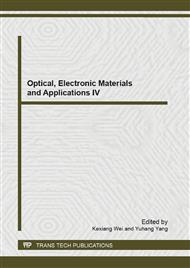[1]
K. W. Lee, D. H. Jung, I. J. Ha, "An online identification method for both stator resistance and back-EMF coefficient of PMSM without rotational transducers," IEEE Transaction on Industry Electronics, vol 51, p.507–510, Apr 2004.
DOI: 10.1109/tie.2004.825280
Google Scholar
[2]
A. Piippo, M. Hinkkanen, J. Luomi, "Analysis of an adaptive observer for sensorless control of interior permanent magnet synchronous motors," IEEE Transaction on Industry Electronic, vol 55, p.570–576, Feb 2008.
DOI: 10.1109/tie.2007.911949
Google Scholar
[3]
M. Eskola and H. Tuusa, "Comparison of MRAS and novel simplemethod for position estimation in PMSM drives," Proc. IEEE PESC, Acapulco, Mexico, vol. 2, p.550–555, Jun 2003.
DOI: 10.1109/pesc.2003.1218115
Google Scholar
[4]
Bologani, S, Tubiana, L, Zigliotto, M, "Extended Kalman Filter Tuning in Sensorless PMSM Drives," IEEE Transaction on Industry Applications, vol 39, p.1741–1747, Nov-Dec 2003.
DOI: 10.1109/tia.2003.818991
Google Scholar
[5]
Chan, T. F., Wang, W., Borsje, P., Wong, Y. K., "Sensorless Permanent-magnet Synchronous Motor Drive Using a Reduced-order Rotor Flux Observer," IET Electric Power Applications, vol 2, p.88–98, Mar 2008.
DOI: 10.1049/iet-epa:20070234
Google Scholar
[6]
T. Kereszty, V.-M. Leppanen, and J. Luomi, "Sensorless Control of Surface Magnet Synchronous Motors at Low Speeds Using Low-Frequency Signal Injection," in Proc. IECON'03, Nov. 2003, pp.1239-1243.
DOI: 10.1109/iecon.2003.1280230
Google Scholar
[7]
Hyunbae Kim, Lorenz, R. D, "Carrier Signal Injection based Sensorless Control Methods for IPM Synchronous Machine Drives," IEEE IAS Annual Meeting, vol 2, p.977–984, Oct 2004.
DOI: 10.1109/ias.2004.1348532
Google Scholar
[8]
Ying FENG, Bo ZHOU, Ying LIU, Shuai LI. Sensorless control of SPMSM based on high-frequency current signal injection in the direct axis at low and zero speed. ICMST 2011.ingapore, pp.2856-2861, Sep.(2011)
DOI: 10.4028/www.scientific.net/amr.383-390.2856
Google Scholar
[9]
Frederik M. L. De Belie, Peter Sergeant, Jan A. Melkebeek. "A Sensorless Drive by Applying the Average-Current Samples," IEEE Transactions on Power Electronics, vol 25, p.875–887, Apr 2010.
DOI: 10.1109/tpel.2009.2036617
Google Scholar
[10]
Matti Eskola,Heikki Tuusa. Sensorless control of salient pole PMSM using at low -frequency signal injection[J].EPE, 2005:1-10.
DOI: 10.1109/epe.2005.219749
Google Scholar
[11]
ShanshanWu,Yongdong Li,Xuejin Miao.Two signal injection methods for sensorless control of PMSM at very low speeds[J]. IEEE PESC 2007:568-573.
DOI: 10.1109/epe.2007.4417540
Google Scholar
[12]
Jianggan Hu, Jingbo Liu, Longya Xu. "Eddy Current Effects on Rotor Position Estimation and Magnetic Pole Identification of PMSM at Zero and Low Speeds," IEEE Transactions on Power Electronics, vol 23, p.2565–2575, Sep 2008.
DOI: 10.1109/tpel.2008.2002087
Google Scholar


